As an Amazon Associate I earn from qualifying purchases.
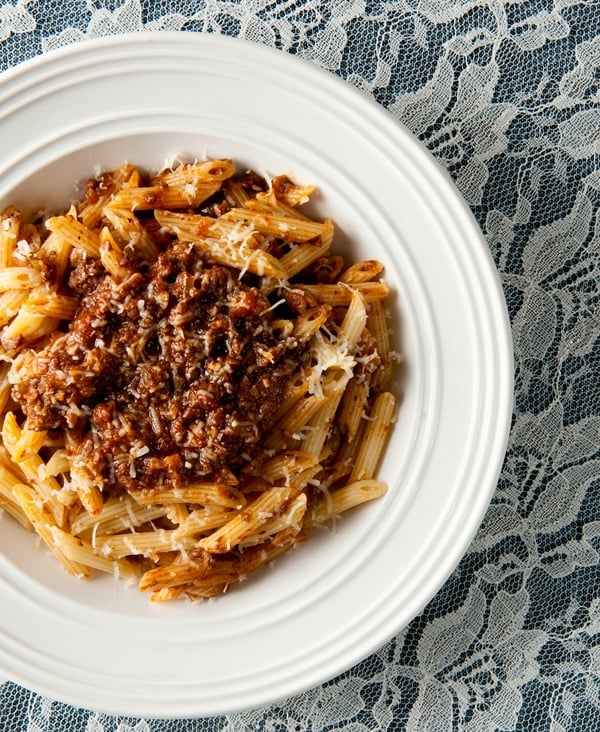
Have you ever had a real, authentic Bolognese sauce recipe? I mean an actual, honest-to-goodness Bolognese? It’s just different from a typical meat sauce for pasta: smoother, meatier, mellower and a lot richer than a typical ragu or sugo. A little goes a long way.
There is a reason that the guardians of this sauce are so strict about what is and is not an authentic Bolognese.
Much of what makes Italian cuisine so special is its skill with poverty foods. Puglians or Sardinians or the people of the Italian Alps must deal with a limited set of ingredients, and they do so with uncanny ability.
But there is no need for this in Emilia-Romagna, where Bologna lies. This region has everything. And it flaunts it. A Bolognese sauce is a crowning expression of the wealth of Italy’s breadbasket, and some version of it has been made since the 1700s.
This is a sauce with rules. It is built on a base of onion, carrot and celery. No garlic. Nor does it have lots of herbs in it. I love lots of herbs in a meat sauce, but that’s not a Bolognese. The sauce contains dairy products. Tomato, while present, is not the star of the sauce. Meat is. And to make a real Bolognese, it must cook a long, long time.
An authentic Bolognese sauce recipe is all about the meat. Emilia-Romagna is a rich region, and this is a rich sauce. Beef is king here, and the sauce is usually a celebration of the cow: beef, veal, milk and butter. But pork is often used, too. And that’s where we start getting into the endless Bolognese Debate — what is, and is not, a “true” Bolognese sauce?
Every cook has a personal version. The few constants I’ve just mentioned above. Some have only beef. Some a mix of meats. Some pork. A few, like this one, wild boar. Some Bolognese recipes use a little pancetta, prosciutto or chicken liver, too.
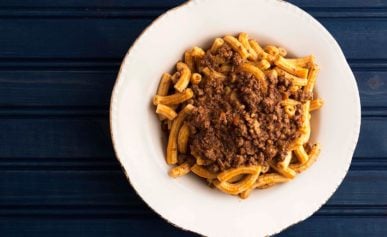
Pigeon, Dove or Duck Ragu
This cousin of Bolognese sauce uses duck, squab or similar meats to make a dark, rich sauce every bit as good as Bolognese.
Read MoreOne point of contention is tomato. I use just a little, but most American versions make this a tomato sauce with meat. That may taste nice, but it’s not a Bolognese. I suspect Americans do this because we were first exposed to a sauce sorta-kinda like this by Italians from Southern Italy, where tomato-heavy meat sauces are more common.
Mushrooms, usually porcini, do have a place in an authentic Bolognese sauce. I use dried ones here. Broth is yet another debating point. Many recipes use beef broth, some use water. I used wild boar broth to go with the meat.
Wine? Yes, or no. Your choice. White or red both work.
What pasta you serve it on is also hotly debated. By far the most common is homemade tagliatelle, which is a little like linguine. But other pasta shapes are seen, too.
Curiously, spaghetti — the most common pasta used with Bolognese in America — is almost never used with this sauce in Italy. Again, I think using spaghetti is an influence from Italian-Americans from the south, where dried pasta is more commonly used.
Do you need to follow all these rules when you make your own Bolognese? I hope you do, because the result is unlike anything else you’ve ever tasted. Even if you use other meats, such as venison or hare or duck, following these guidelines will make an unforgettable pasta sauce.
But the Italian Food Police will not come breaking down your door if you add a little of this or a little of that to your liking. Improvisation is, after all, very Italian.
Venison Ragu
Ingredients
- 4 tablespoons unsalted butter
- 1 cup minced onion
- 1 cup minced carrot
- 1 cup minced celery
- 2 pounds ground venison, or other meat
- 1 ounce dried porcini, reconstituted in 1 cup hot water and chopped
- 1 six- ounce can tomato paste
- 1 cup venison stock, beef broth or water
- 1 cup red wine
- 1 cup milk
- 1/2 nutmeg, grated or 1/2 teaspoon ground nutmeg
- Salt and black pepper to taste
- Pasta (tagliatelle, penne, etc)
- Grated cheese for garnish
Instructions
- Heat the butter over medium-high heat in a large, heavy pot like a Dutch oven. Add the onion, celery and carrots and cook gently for 5 to 8 minutes, stirring often. Do not brown them. Sprinkle a little salt over the veggies as they cook.
- When the vegetables are soft, stir in the chopped porcini and tomato paste and allow everything to cook for 3 or 4 minutes, again, stirring often. When the tomato paste begins to turn the color of brick, add the ground venison, the porcini soaking water and the broth. Bring to a simmer.
- Allow this to cook down over medium-low heat. Take your time here and resist the urge to do this over higher heat. Stir from time to time. When the liquid has mostly evaporated, add the wine and repeat the process. When that has mostly evaporated, add the milk, nutmeg and black pepper and stir well. Bring back to a simmer and add salt to taste. Let this cook until it is the consistency you want.
- To serve, put the pasta in a large bowl and add a healthy ladle of sauce. Toss to combine. Give everyone their portion, then top with a small ladle's worth of sauce. Grate the cheese over the top and serve.
Video
Notes
Keys to Success
- Time. A real deal ragu takes time to make. You can rush things, but you will notice the difference.
- I make my own venison stock for this recipe, but you could use store bought, low-sodium beef broth.
- Use a food processor to finely mince the carrot, onion and celery. Way easier than by hand.
- If you can't find the porcini, skip it or use other dried mushrooms. I will often just use porcini powder.
Nutrition
Nutrition information is automatically calculated, so should only be used as an approximation.
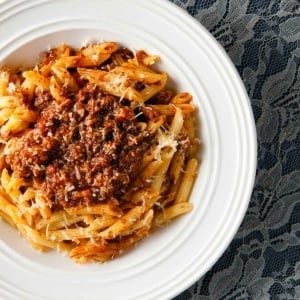
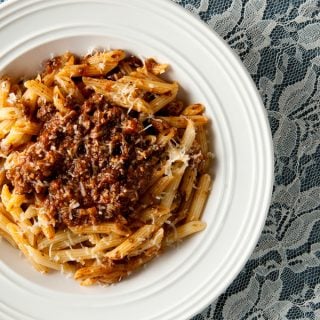
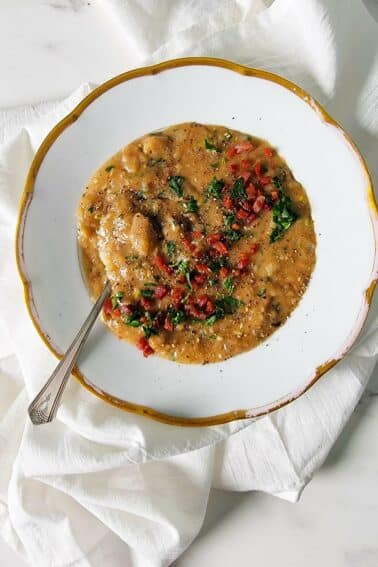

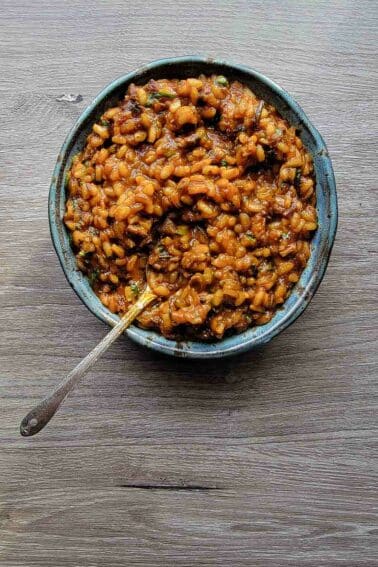

I made this last weekend and it was delicious! Rich and meaty. I used a combination of ground pork, beef, and veal. I didn’t have dried porcini so I used fresh button mushrooms. That probably took away some depth of flavor but it was still very good. Like you, I love nutmeg – I added a lot! 🙂
thank you, thank you, THANK YOU Hank for telling it like it is w/ Bolognese sauce. This is a dish with rules b/c of it’s history. The coolest thing about Bolognese sauce, to me, is the dish isn’t just regional to Italy (Emilia Romagna) but it’s almost regional within BOLOGNA itself! There are different tweaks to the dish depending on the family. Some have almost no tomato sauce (sometimes just a small squeeze of tomato paste at the very beginning which gets browned). like you mentioned, some use liver (which we’ve tried before and it is GOOD). some add cream. i LOVE that you used the wild boar (which is so prevalent on menus in Italy). i wish we could get that meat more easily here in the states. awesome dish – and true to the “rules”.
I’m very impressed with myself that I actually make (5 yrs and going) the almost exact bolganese that you’ve written. I add 1cup of spanish olives while cooking.
Golf clap
I also make a killer wild boar lasagna with this recipe except i add a béchamel sauce instead of cheese. I top it off with Parmasean at the end after baking.
love bolognese. Did one for my blog too and now totally addicted 🙂 Did add the livers to mine…need no excuse to throw liver in things, love the stuff !
Thanks Michael, I should have clarified, this is wild duck, which is quite lean, especially compared to domestic. A super fatty wild duck might have 1/4″ of fat. Since I shot quite a number in a year, I tend to breast them out, and save the more shot up ones for sausage etc where I cut out the bad spots.
ian, i just used the dark meat of the duck, the stuff near the joints. that plus the liver, plus milk… made an absolutely outstanding sugo. duck is fatty. i don’t think there’s a reason to use additional fat.
Hank,
For years I’ve been wanting to make one with duck/goose, just add some pork fat?, or cut it with pork/beef? My duckeroni I use 30%ish very fatty pork, any base direction would be wonderful.
Very best,
ian
i love the recipe from mediterranean diet cookbook (nancy harmon jenkins)–mita’s tuscan sugo. that one, and marcella hazan’s bolognese, set the bar for all meat sauces, though they’re quite different. i love the addition of milk (marcella does it; nancy doesn’t).
every year we cook up a bunch of ducks (domestic) and i make a hand-chopped sugo from duck meat–all the tasty bits left after butchering for confit, smoked breasts, etc. i always add the livers and hearts, too. hand chopped meat has a wonderful texture.
Federico: Yeah, I know it’s called ragu in Emilia-Romagna, but I am writing for Americans, and since there are all kinds of ragus out there — not all of them from the area around Bologna — here it’s Bolognese. And I agree about the Tuscans. This is not their sauce. 😉
Huhhhh . . . where to begin Hank. Congrats on a brilliant post on this “sauce”. My Italian friend also avers “no” to the garlic. For myself, I cannot get to where I’m completely convinced anyone “knows” this recipe, but the website link requested at this LEAVE COMMENT area has my link to Ragù alla Bolognese – What is “Meat Sauce”? Maybe we should combine forces for this ragù.
Hank, I hate to say but I will have to break your thumbs. You are letting me down, big time! It’s called ragù, not bolognese. Once upon a time I though it was possible to educate people about this trivial point. Unfortunately it turns out the trivial point is not that trivial because people just don’t wanna learn. Apparently force is needed to help the learning process.
Let’s also keep the frikkin’ tuscans out of it as well, the pox on their house. The sorry asses ain’t got a horse in this race.
Gosh darn, Hank – I’m totally impressed. Your observations about the tomato in particular, were spot on. What a great post! Loved the bolognese with wild boar – just like a true Tuscan.
I do a version of this and I always finely chop up a couple of chicken livers and add in with whatever meat I am using. I find this gives it a richness like no other.
E.A.T.
Florian: You can use less. I like nutmeg.
Dan: Yep, I cut all my ground game with 20-30 percent pork fat. I get my pork fat from good farmers, not factory hogs, so I am cool with it. In your case I’d use a fair amount of butter to compensate for the lack of fat in the meat.
I had something like this a million years ago in a little village in the woods in northern Italy… I still remember it and the earthy papardelle they served with it. It rocked my world and I can’t wait to try the recipe… many thanks.
I have made it with Elk. Very similar recipe – with milk. I have always wondered about the origin of that ingredient in this sauce.
You had me on “no garlic”. I don’t do well with garlic and since I’ve been trying to avoid it I’ve noticed how it seems to be in everything! And in tiny little minces that you can avoid when eating! I’m going to try this your way…perhaps not with boar but some pancetta…and beef and veal.
This looks fantastic. I am always looking for wild boar recipes. Can’t wait to try it.
Hi Hank I have a general question when using something like ground venison in your recipes. Do you assume some amount of fat in the venison. I grind my own venison from deer I have shot and it is extremely lean. When you describe using ground game in a recipe is there pork fat or some other fat added into the meat at some standard ratio? I have always had trouble reconciling the use of farm raised pork fat in my “clean” wild meat.
It looks delicious, but it seems like a lot of nutmeg!